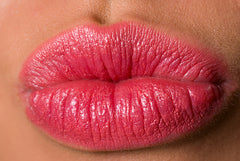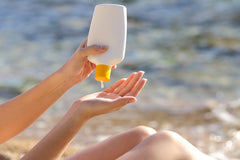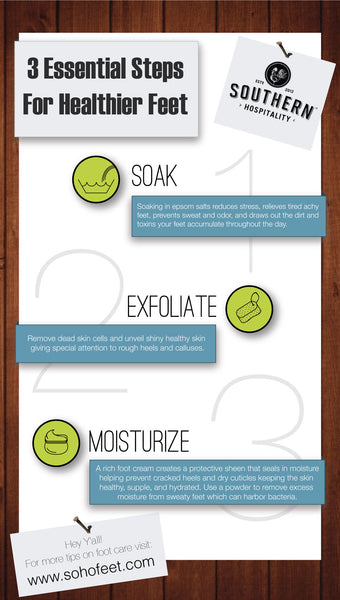Why You Need Shower Shoes at The Gym


Southern Hospitality answers why you should NEVER walk barefoot in public showers at the gym. Special thanks to SELF!
http://www.self.com/story/plantar-wart-gym-showers
Putting your best FEET forward,
SH
Southern Hospitality on Inside Indiana Business: Last Minute Holiday Gifts
Southern Hospitality gets featured on the TRENDiana segment of Inside Indiana Business for last minute holiday gifts!
IndyStyle
Check us out on IndyStyle!
Safety's Only Skin Deep

Looks like beauty isn’t the only thing that is skin deep. Check out these 3 common types of skin cancer that can turn YOUR summer into an absolute bummer.
Basal Cell Carcinoma
What is it: The most common form of skin cancer that spreads slowly. Appears as a smooth shiny nodule on the skin.
Who is most likely affected: Individuals with a fair skin complexion are most at risk.
Where does it strike: The face is most common, but can be found on any area of the body subject to long term sun damage
When does it occur: Adults over 40 are most commonly diagnosed.
Squamous Cell Carcinoma
What is it: Aggressive form of skin cancer that begins as a scaly red inflamed nodule that develops into an ulcer. Early diagnosis is key because it spreads very quickly.
Who is most likely affected: Fair skinned individuals beware! But anyone who has been subject to prolonged sun exposure should listen up. Smoking can also be a cause.
Where does it strike: The face and back of the hands are the problem areas for men, while the legs and feet are most common for women.
When does it occur: Adults 55 years or older.
Melanoma
What is it: The most deadly- but least common- form of skin cancer. Usually forms from a pre-existing mole or pigmented lesion that is asymmetrical and deformed. Spreads rapidly.
Who is most likely affected: People with light skin complexions are most at risk, especially those with freckles, red hair, or those who burn easily. However as much as 10% of those affected are of dark complexion.
Where does it strike: Areas most exposed to the sun (noticing a theme here?). The face is a common area for men and the legs for women. The soles of the hands and feet and the nails are most often affected by those with darker skin.
When does it occur: Usually found in those that are 50+, but can occur as early as 30 years of age.
As always, monitor the amount of time that you spend in the sun. If you are going to be exposed to the sun for extended periods of time always apply (and RE-apply) your sunscreen when needed. Inspect your skin regularly, and if you note any changes or formations of skin lesions report to your physician immediately. Early diagnosis is key!
Putting your best FEET forward,
SH
5 Areas You Don’t Want to Forget to Apply Sunscreen

So you think you’ve slathered on your sunscreen and are ready for a day of fun in the sun…but have you considered these areas? You better!
From HEAD…
Scalp: 
Whether you’re bald or have long luscious locks, an exposed scalp should not be taken lightly for sun protection. Even the smallest part in your (hair)do can reveal enough skin for the sun to do damage. Studies show that melanoma on the scalp can result in a faster rate of death than any other part of the body.
Ears: 
Arms, legs, and face…CHECK! But did you get your ears? They are the 3rd most common site for skin cancer from the sun and should NEVER go untouched. If sunscreen for your ears doesn’t tickle your fancy, try a nice hat with a wide brim to shield you from the sun.
Lips: 
Did you miss a spot with your sunscreen, but can’t figure out where? It could be right under your nose- literally! That’s right the thinner skin and lack of melanin in your lips make them especially vulnerable to the damage from harmful sun rays. It’s best to use lip balm with SPF to keep your kisser in good condition!
Hands: 
They assist you in applying sunscreen to every other part of your body but it’s easy to forget they need a little help being protected from the sun. The palms may be slathered with sunscreen, but don’t forget the back of your hands.
To TOE…
Feet: 
Going barefoot or wearing sandals means your feet are largely uncovered. That makes your feet very susceptible to sun’s harmful rays. Take care to apply sunscreen to the tops & soles of the feet. Don’t forget between the toes! It is a common hideout spot for melanoma of the feet that should NEVER go unnoticed! Don’t forget the nails!
Putting your best FEET forward,
SH
Sandal Season Survival Series TIP #2: Pssst! Your Epidermis Is Showing

Wanna REALLY get sandal season into full swing?...Then sunscreen is an absolute must-have to keep in your arsenal to survive the summer safely. The face, back, arms and legs are all the craze when it comes to applying sunscreen, but it’s also a very good idea to slather the tootsies to protect them from the harmful sun rays. To protect your feet from the sun:
• Apply sunscreen with a minimum Sun Protection Factor (SPF) of 30. You want to lookout for sunscreens that are labeled “water-resistant” and “broad spectrum” that hold up against water exposure and protect you from both UVB (contributes to melanoma) and UVA (causes skin damage) rays.
• Sunscreen should be applied at least 30 minutes prior to going outdoors. It takes approximately 15 minutes for your skin to fully absorb the sunscreen you apply. If you wait until you are outside to apply, you run the harmful risk of your skin becoming scorched by the sun.
• Make sure ALL exposed skin is protected. Wearing sandals means your feet are largely uncovered. That makes your feet very susceptible to sun’s harmful rays. Take care to apply sunscreen to the tops & soles of the feet. Don’t forget between the toes! It is a common hideout spot for melanoma of the feet that should NEVER go unnoticed! With creams you always want to be careful when applying between the toes however. Do not place too much cream in between the toes to prevent any macerations (breakdown) of the skin.
• Reapply! Just because you applied sunscreen before going outdoors does not mean you’re fully protected. You should always reapply sunscreen every 1-2 hours while frolicking in the sun. Certain factors such as water exposure, excessive sweating, and individuals with reduced skin pigmentation may require more frequent reapplications.
No matter if it’s the summertime or any other time of the year, ALWAYS inspect your skin for any potential changes, paying very close attention to any moles or lesions that may be present. If you suspect any changes in your skin, report to your physician immediately!
Tip #3 on the way…
Putting your best FEET forward,
SH
Infographic Series - 3 Steps to Healthier Feet
Last month we talked about the steps to healthier feet. Here's a cute visual and easy way to remember in 3 steps! Just click on the infographic for a larger view. We'll be posting more of these in the coming weeks so make sure to follow us on Twitter!
It’s Easy as 1, 2, 3:Essential Vitamins for Fit, Healthy Feet (Part 2)

…and now back to class. It’s time to learn the rest of your ABC’s of healthy feet!
Vitamin D[Ergocalciferol(vitamin D2),Cholecalciferol (vitamin D3)]
Benefits: Calcium gets most of the credit for the development of strong healthy bones, but it’s vitamin D- specifically D3- that allows our bodies to absorb and utilize calcium. In terms of the feet, stress fractures and overuse injuries can be minimized with this vitamin in our dietary arsenal.
Source: Sunlight, fortified dairy products, eggs, salmon, mackerel, vitamin supplement
Attention: Athletes, runners, dancers, children, postmenopausal women, elderly, diabetics
Oh by the way: Wearing sunscreen can prevent absorption of vitamin D from sunlight. However, going without sunscreen can be damaging to the skin against the sun’s harmful rays (Skin cancer…I think NOT). Therefore, a sound diet may be the best approach to receive your supply of vitamin D. Fat-soluble.
Vitamin E (alpha-tocopherol)
Benefits: Gimme an E! This wonderful nutrient functions to do away with those pesky free radicals. Together with vitamins A & C, your feet maintain healthy skin, preventing invasion of fungus, viruses, and bacteria!
Source: Almonds, leafy green vegetables, olive oil, sweet potatoes, sunflower seeds, vitamin supplement
Attention: Diabetics, beach-goers
Oh by the way: Studies have shown that vitamin E contributes to fighting heart disease and plaque formation in arteries, although results are not conclusive. Fat-soluble.
Vitamin K (Phytonadione)
Benefits: Known for blood clot formation, vitamin K fights excessive bleeding from punctures and other open wounds. Walking barefoot?...Think twice!... Shoeless feet are highly prone to stepping on foreign objects- rocks, glass, nails, and twigs, among others. Vitamin K is also capable of strengthening bones.
Source: Spinach, turnip greens, cabbage, broccoli, kale
Attention: Burn victims, diabetics, beach-goers, athletes, postmenopausal women
Oh by the way: People- with a history of heart disease or peripheral vascular disease (PVD) - who take blood thinners (such as Coumadin [Warfarin] or even aspirin) may be advised by their physician to minimize their intake of vitamin K, to prevent formation of blood clots in the bloodstream. Fat-soluble.
Putting your best FEET forward,
SH
It’s Easy as 1, 2, 3:Essential Vitamins for Fit, Healthy Feet (Part 1)

Who can forget learning their ABC’s as a kid? From A to Z, we utilize the building blocks of communication that allow us to speak, read, and write. But allow us to introduce you to a new set of ABC’s……the ABC’s of healthy feet!
Vitamin A (Retinol, Retinoid)
Benefits: Known to develop keen eyesight and smoothing under eye wrinkles, vitamin A works wonders to keep the rough areas of the feet silky smooth. Acting as a safeguard during the winter months- against cracked heels- and a protector of sun damaged feet during the summer months (yikes!), vitamin A is an absolute must-have to revive tissues, scrapes, lesions, and wounds of the feet.
Source: Carrots, liver, paprika, sweet potatoes, leafy green vegetables, topical lotions/creams
Attention: Diabetics, beach-goers, people with psoriasis
Oh by the way: Vitamin A is classified as fat-soluble, meaning: 1) it travels from the fat, 2) into the bloodstream (to be used by the body) 3) and the excess IS stored in the liver; daily supply is NOT required in diet.
Vitamin B12 (Cobalamin, Cyanocobalamin)
Benefits: Numbness, burning, and tingling of the feet BEGONE with this B vitamin. Found to develop and maintain nerve conduction, vitamin B12 is essential from head-to-toe. A healthy nervous system enables our feet to maintain balance and sensation (for touching). Listen up diabetics!!......this vitamin is for you!
Source: Clams, fortified cereals/whole grains, milk, eggs, poultry, vitamin supplement or injection
Attention: Vegans, vegetarians, diabetics, the elderly, people with gastrointestinal surgery
Oh by the way: Nutrient is not found in plants NATURALLY- plants can be fortified with the nutrient, however; daily recommended amounts can be received via vitamin supplement. Classified as water-soluble, vitamin B12 dissolves directly in the bloodstream and is NOT stored in the body; excess is eliminated in the urine; a continuous daily supply IS needed in our diet.
Vitamin C (Ascorbic acid)
Benefits: Free-radicals don’t stand a chance against vitamin C. As a notable antioxidant, vitamin C plays a key role in the production of collagen, helping to keep the skin firm and strong. Hangnails and ingrown toenails?……..That’s ok! Vitamin C has got you covered.
Source: Oranges, spinach, brussels sprouts, green pepper, grapefruit, topical lotion/creams
Attention: Diabetics, beach-goers
Oh by the way: May alleviate the effects of sun damaged skin- sun spots and hyperpigmentation to name a few. Water-soluble.
** Don't go too far...Come on back for Part 2!!!!!!!!!!! **
Don’t forget to LIKE US on facebook AND follow us on twitter!
Putting your best FEET forward,
SH
SKIN-CREDIBLE: KNOW YOUR SKIN INSIDE AND OUT

Loving the skin you’re in means knowing how the body’s largest organ functions. Knowledge of how your skin functions gives you appreciation of how your skin takes care of you, so you can take care of it.
In this post, you will discover the 3 layers of the skin and their roles to keep you covered.
Epidermis- The Protector 
Serving as your body’s first line of defense, the epidermis is a safeguard against harmful microorganisms and your environment. Keratin- makes up 95% of the protective layer- works to seal in moisture, to maintain your skin’s hydration. Melanin- which contributes to your skin tone- is produced to shield the skin against the sun’s harsh UV rays.
Foot fact:Constant rubbing and friction can contribute to excess keratin formation- better known to the world as corns and calluses- that affects the epidermis. Ill-fitting shoes , walking barefoot, and prolonged walking/running are the common causes.
Dermis- The Provider 
Ever wondered where sweat comes from, or how is it that you are able to touch, and feel changes in temperature? Look no further than the dermis. This middle layer has sweat glands galore- to regulate body temperature- and loaded with nerve endings- to provide sensation. Collagen is a prime protein that maintains skin structure and strength, while blood vessels supply your skin with nutrients.
Foot fact:The dermis is the primary location for hair follicles. However parts of the body, such as the soles of the feet, lack these structures.
Hypodermis- The Foundation 
What’s in a name? Well,…everything! Hypodermis literally means: below (hypo) skin (derm). As the deepest layer, the hypodermis fastens the skin to the underlying structures (bones, organs, muscles, etc.) in the body. It is primarily composed of fat- aka adipose tissue- that provides much needed insulation and a layer of shock absorption from impact. Who knew fat could be a good thing?!
Foot fact:Fat pads at the heels and balls of the feet serve as protective padding for internal structures when walking/running. Those fat pads can diminish- in a condition known as fat pad atrophy- that can result in painful steps when walking (esp. barefoot). To manage, wear soft, cushioned insoles. Athletes and the elderly are most at risk.
Putting your best FEET forward,
SH






